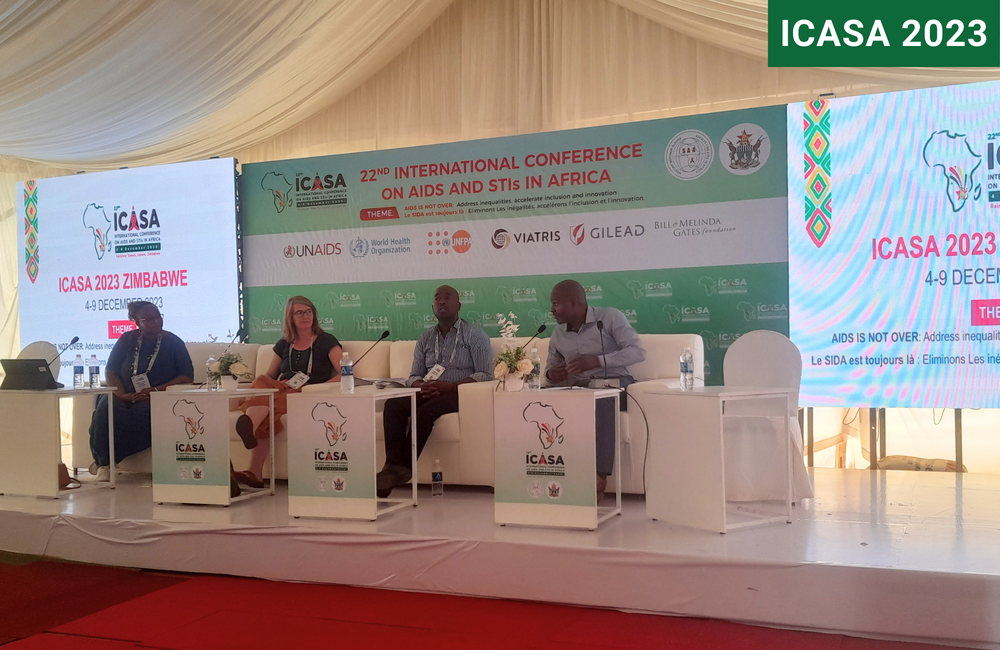
Non-communicable diseases are now a significant cause of mortality for people with HIV in Zimbabwe, but people with HIV are less likely to have their condition diagnosed than people in the general population and many health facilities lack basic equipment needed for screening, the 22nd International Conference on AIDS and STIs in Africa (ICASA 2023) heard last week in Harare, Zimbabwe.
The global introduction and expansion of antiretroviral therapy (ART) has resulted in higher life expectancy for people living with HIV. In PEPFAR-supported countries, the proportion of people receiving HIV treatment aged 50 years and above has increased from 11% to 21% between 2017 and 2021.
In Zimbabwe, 54% of people with HIV are now 40 years and older. To understand the causes of death, Dr Nkazimulo Tshuma of AIDS Healthcare Foundation and colleagues analysed data from the Mpilo Centre of Excellence, an HIV clinic in Harare.
The clinic provided care to 10,507 HIV-positive clients from January to December 2022. There were 129 deaths, resulting in a mortality rate of 13 deaths per 1000 individuals with HIV. The median age of those who died was 44, evenly split between men and women.
The majority of individuals who died were ART-experienced (63%), and at the time of death, 55% had a viral load of less than 50 copies, while 34% had a viral load of over 1000 copies. Most of them (74%) were using the first-line dolutegravir-based regimen. The leading causes of death were tuberculosis (21%), renal failure (14%), cancers (14%) and meningitis (10%). Answering a question from the audience, Dr Tshuma said that cervical cancer was the leading cause of cancer deaths
Among those who were not on ART, 79% had advanced HIV disease, and 74% had CD4 of less than 200ml. The leading cause of death was tuberculosis (48%), followed by meningitis (25%) and stroke (6%).
Of the 21 people who died from non-communicable diseases, 67% had a viral load of 50 copies or less.
With non-communicable diseases emerging as a significant cause of mortality, another Zimbabwean study compared the burden of hypertension and diabetes in people over the age of 40 enrolled in ART care and in the general population.
The screening project was conducted in Bulawayo and a Harare suburb. The programme trained health workers on the integration of hypertension and diabetes screening among people living with HIV and adults from the general population who are at risk of the conditions.
Over nine months, a total of 69,936 people underwent screening for hypertension and diabetes mellitus. Of these, 63% came from the general population, while the remaining 37% were individuals living with HIV.
In both groups, four out of every ten adults who underwent screening were hypertensive (40% of people living with HIV over the age of 40, 44% of people over 40 in the general population). Diabetes mellitus was less prevalent, with only 0.7% of individuals living with HIV and 1.1% of the general population being diagnosed with the condition.
But there were significant differences in terms of a previous diagnosis. While 23% of the general population had been previously diagnosed with hypertension, only 14% of people living with HIV had been diagnosed before this study. Similarly, while 5% of those screened from the general population had been previously diagnosed with diabetes, only 2% of people living with HIV had a prior diagnosis.
These findings highlight the need to improve the availability of screening tools for non-communicable diseases in HIV treatment centres. While patients are currently invited to attend specialist clinics for screening of other conditions, travel times and other barriers discourage many from attending.
Giving an example from Newlands Clinic in Harare, Dr Cleophas Chimbetete shared results from the first 100 patients reviewed since October 2022 in their new integrated HIV-geriatric clinic. All patients aged 65 years and over who received routine HIV care were evaluated by a multidisciplinary team for a 90-minute comprehensive geriatric assessment, including cardiovascular risk, mental health, cognition, nutrition, fracture risk, and geriatric syndromes such as falls and frailty.
There was a high prevalence of non-communicable diseases noted, with 80% of the attendees having hypertension, 20% diabetes and 43% chronic kidney disease. The median number of co-morbidities and co-medications among the attendees were three and four, respectively.
The integrated clinic identified several previously unrecognised issues, and 86% of the attendees received interventions during the visit. Among these interventions, 76% of the attendees were given new diagnoses, including cognitive impairment (21%), depression or anxiety (26%), osteoporosis (18%), vitamin B12 deficiency requiring treatment (55%), and prostate cancer in three men.
"In 2023, its unfair, it's unethical, it's borderline criminal to run an opportunistic infections clinic without a blood pressure machine, without the ability to test blood sugar and yet say we are offering comprehensive care,” concluded Dr Chimbetete. “In addition, lets screen for common cancers and also provide mental health services."
Special session: Aging and HIV. 22nd International Conference on AIDS and STIs in Africa, Harare, 2023.
Tshuma N I et al. Analysis of causes and clinical determinants of mortality among people living with HIV at Mpilo Centre of Excellence, Bulawayo. 22nd International Conference on AIDS and STIs in Africa, Harare, abstract FRAB1802, 2023.
Takarinda K et al. Integrating NCD screening into routine HIV care among older adults enrolled on ART: Lessons learnt from a project in Zimbabwe. 22nd International Conference on AIDS and STIs in Africa, Harare, abstract FRPEA017, 2023.
